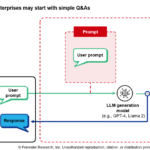Digital Transformation Is A Cornerstone Of Innovation And Sustainable Growth
The World Economic Forum estimates that more than two-thirds of new value creation over the next decade could come from digitally enabled platforms. Forrester’s new Global Digital Economy Forecast measures the size and growth of the digital economy across technology spend, retail, travel e-commerce, insurance e-commerce, information and communication technology (ICT) product and service exports, chip manufacturing, and data centers. The top six digital economies by size are the US, China, the UK, Japan, Germany, and South Korea. The digital economy will see 6.9% CAGR from 2023 to 2028, growing faster than global GDP. The digital economy is driven by:
- E-commerce, tech spend, and exports. Online retail and online travel will increase their share of the digital economy, with 9% and 7% CAGR from 2023 to 2028, respectively. Technology spending is the principal contributor to the digital economies of France, Italy, Spain, Canada, Brazil, the US, the UK, Japan, and Germany. ICT product and service exports capture the largest share of digital economies in India, South Korea, and Mexico.
- The US and China. Almost two-thirds of the global digital economy comes from the US and China. The US, with 4.2% of the global population and 26% of global GDP, captures 42% of global technology spending. E-commerce captures the largest share of the digital economy in China with 39% of retail sales bought online in 2024, which will rise to 41% by 2028.
- Digital R&D spend. A country’s R&D expenditure as a share of GDP correlates with its digital economy share of GDP. South Korea spends the largest share of its economy on R&D, with focused investment on AI, semiconductors for AI, 5G and 6G, quantum, metaverse, and cybersecurity. The Indian government launched Digital India futureLABS to strengthen R&D and innovation investment. Digital investment lags in Europe, with average tech spend growth per year from 2024 to 2027 forecasted to reach €83 billion, significantly lower than the €125 billion required by the European Commission to reach digital growth targets.
To nurture the growth of the digital economy, countries must focus on digital businesses, public services, digital skills availability, the growth of R&D spend, and tech investments that influence non-digital activities. Forrester’s Global Digital Economy Forecast, 2023 To 2028, shows that the digital economy will reach $16.5 trillion and capture 17% of global GDP by 2028 for 14 countries across North America, Europe, APAC, and Latin America.
Have any thoughts? Contact me, Michael O’Grady.
Forrester clients can schedule a Forrester guidance session for more insights and to explore the narratives within this forecast.








